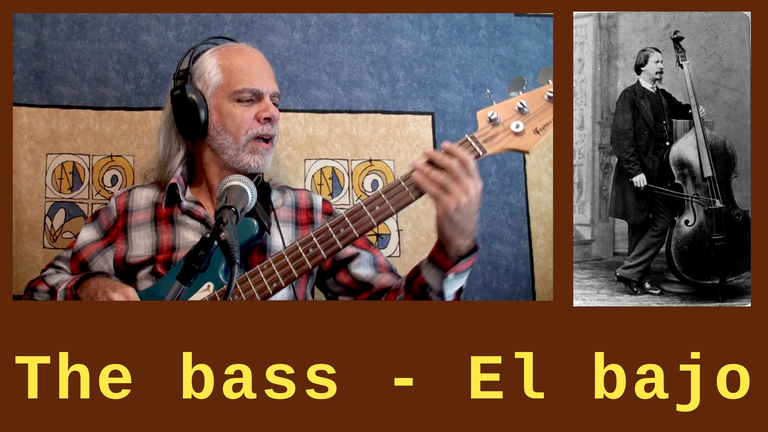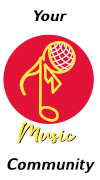When I started making these videos about the instruments that I included in my salsa orchestra, the idea was to make short films, or #shorts as they are usually called on digital platforms.
However, many people have asked me to expand the stories I tell, which usually include part of the history of the instrument and part about its incorporation into Latin music.
I thought about making them a little longer, but after recording this one, I realized that it was too long (since I never use a script, everything is always improvised). Then I wanted to edit it to make it shorter, but I couldn't find the parts to cut, so today's video is the longest of the series.
But I think my extension on this subject is because it is one of my favorite instruments and its history is exciting.
In the beginning, the idea was not to create an instrument that would mark the fundamental notes of the chords in the orchestra, since that responsibility was given to the bassoon and tuba. The function of this instrument was to play the same melodic lines as the cello, but one or two octaves lower.
However, in order to develop its potential as a true instrument with a wide range of musical possibilities, it had to wait for the development of the industry and the production of the first wound metal strings, which made it possible to build an instrument of more discreet dimensions (compared to the almost two meters that the first versions measured), and with it, a better quality of sound and ease of execution.
By the end of the 19th century this had been achieved and they began to write their own parts in the arrangements and to compose pieces for the double bass as a soloist, and this instrument also found its way into popular music.
Soon it was discovered that it was ideal to mark the rhythmic bases of all kinds of music and at the same time provide support in the harmonic aspect, and this was the key to quickly becoming part of all kinds of groups worldwide.
In Caribbean rhythms (in most countries of the region) the bass began to replace the marimbula, which was the instrument that marked the low frequencies and the rhythmic base of our rhythms. Thus, the double bass entered the son, the rumba, the danzón, throughout the Caribbean.
But the evolution of this instrument was not only in its original form and technique, but in the middle of the twentieth century also electronic versions appeared. The first was the electric double bass, which retained all of its previous characteristics, but in addition to its huge soundboard, it was amplified by means of magnetic microphones.
Then came a version known as the baby bass, which, although its body was made of solid wood and it had no soundboard, kept a decorative appearance similar to the double bass (although smaller) and the way it was played, except that it did not use a bow.
With further advances in the development of strings and the birth of the electric guitar, the first electric bass soon appeared in the form of a guitar.
If there was anyone who revolutionized the concept of this instrument, it was the jazzman Jaco Pastorius, who, in my opinion, was the one who, with his virtuosity, turned the bass into a solo instrument and demonstrated the enormous potential it had.
Among the first double bass players who stood out in Cuban music, it is necessary to point out the Cuban Cachao López, but there are many names associated with this instrument.
The baby bass did not have the commercial success that its makers expected, but strangely enough it became a standard in Latin music and today most salsa groups prefer this sound. Without a doubt, the best representative of this instrument is Oscar d'León, especially for his ability to sing, dance and play at the same time. But it is also necessary to mention Bobby Valentín.
The latter also played the chest bass (or bass guitar), but with this version of the instrument, the name that most comes to mind for lovers of the genre is that of the extraordinary Salvador Cuevas.
Although my album features a baby bass in some of the songs, for my project I chose the guitar bass, which doesn't have the "fat" sound of the baby bass, but it has more freedom of execution, an openness in the notes and a sustained sound that only this variant can offer.
But in any case, the bass guitar is an essential instrument in any musical project.

Cuando empecé a hacer estos videos sobre los instrumentos que yo incluí en mi orquesta de salsa, la idea era hacer puros cortos o #shorts, como se le suele llamar en la plataformas digitales.
Sin embargo, es mucha la gente que me ha pedido que me extienda más en las historias que cuento, que por lo general incluye parte de la historia del instrumento y parte sobre su incorporación a la música latina.
Pensé en alargarlos solo un poco, pero después de grabar este, me di cuenta que había quedado demasiado largo (pues nunca uso guión, todo es siempre improvisando). Luego quise editarlo para hacerlo más corto, pero no hallaba qué partes eliminar, así que este de hoy, es el video más largo dd la serie.
Pero yo creo que la extensión mía en el tema, es porque se trata de uno de mis instrumentos preferidos y su historia es apasionante.
En un principio, la idea no era crear el instrumento que marcara las notas fundamentales de los acordes en la orquesta, pues esa responsabilidad la tenía el fagot y la tuba. Este instrumento tenía la función de tocar las mismas líneas melódicas del violonchelo, pero una o dose octavas más abajo.
Pero para desarrollar su potencial como un verdadero instrumento y con amplias capacidades musicales, tuvo que esperar el desarrollo de la industria y que se pudieran producir las primeras cuerdas entorchadas de metal, que fueron las que permitieron hacer un instrumento de dimensiones más discretas (comparados con los cerca de dos metros que medían las primeras versiones) y con esto también lograron una mejor calidad de sonido y facilidad de ejecución
Para finales del siglo XIX ya se había logrado esto y empezaron a componerse piezas para el contrabajo como solista y este instrumento dio su paso también a la música popular.
Pronto se descubrió que este instrumento era ideal para marcar las bases rítmicas de todo tipo de música y que al mismo tiempo podía brindar apoyo en el aspecto armónico y esa fue la clave para que rápidamente pasar a formar parte de todo tipo de agrupación a nivel mundial.
En los rimo caribeños (en la mayoría de países de la región) el bajo pasó a sustituir la marímbula, que era el instrumento que marcaba las frecuencias bajas y la base rítmica de nuestros ritmos. Así entró el contrabajo en el son, la rumba, el danzón y así lo hizo en todo el Caribe.
Pero el desarrollo de este instrumento no solo fue en su forma original y en cuanto a técnica, sino que para mediados del siglo XX también surgieron las versiones electrónicas. El primero fue el contrabajo eléctrico, que mantenía todas sus características previas, pero además de su enorme caja de resonancia, se amplificaba mediante micrófonos magnéticos.
Luego surgió una versión, conocida como bajo baby, que aunque su cuerpo era de madera maciza y no tenía caja de resonancia, mantenía decorativamente un aspecto parecido al contrabajo (aunque más pequeño).
Con más avances en la elaboración de cuerdas y con el nacimiento de las guitarras eléctricas, muy pronto surgió también el primer bajo eléctrico, con forma de guitarra.
Si hubo alguien que revolucionó el concepto de este instrumento, ese fue el jazzista Jaco Pastorius, que a mi modod de ver, fue quien convirtió el bajo en un instrumento solista y demostró el enorme potencial del instrumento.
De los primero contrabajistas que destacaron en la música cubana, es necesario señalar al cubano Cachao López, pero son muchos los nombres ligados a este instrumento.
EL bajo baby, no tuvo el éxito comercial que esperaban sus fabricantes, pero curiosamente, en la música latina se convirtió en un estándar y hoy en día, la mayoría de grupos de salsa, prefieren ese sonido. Sin duda, el mejor representante con ese instrumento es Oscar d'León, sobre todo por su habilidad de cantar, bailar y tocarlo al mismo tiempo. Pero allí también es necesario nombrar a Bobby Valentín.
Este último tambikén tocaba el bajo de pecho (o bajo guitarra), pero con esa versión del instrumento el nombre que más nos viene a la mente a los amantes del género, es el del extraordinario Salvador Cuevas.
Aunque para mi disco hay un bajo baby en un par de temas, para mi proyecto yo escogí el bajo guitarra, que aunque no tiene ese sonido "gordo" del bajo baby, cuenta con más libertad de ejecución, una apertura en las notas y un sonido sostenido, que solo esa variante puede ofrecer.

Images sources || Fuente de las imágenes
[1] - [2] - [3] - [4] - [5] - [6]



Vote la-colmena for witness
By @ylich
http://ylich.com
Spotify
Buy Ylich's "Pa' los bailadores" NFT at nfttunz.io
▶️ 3Speak

